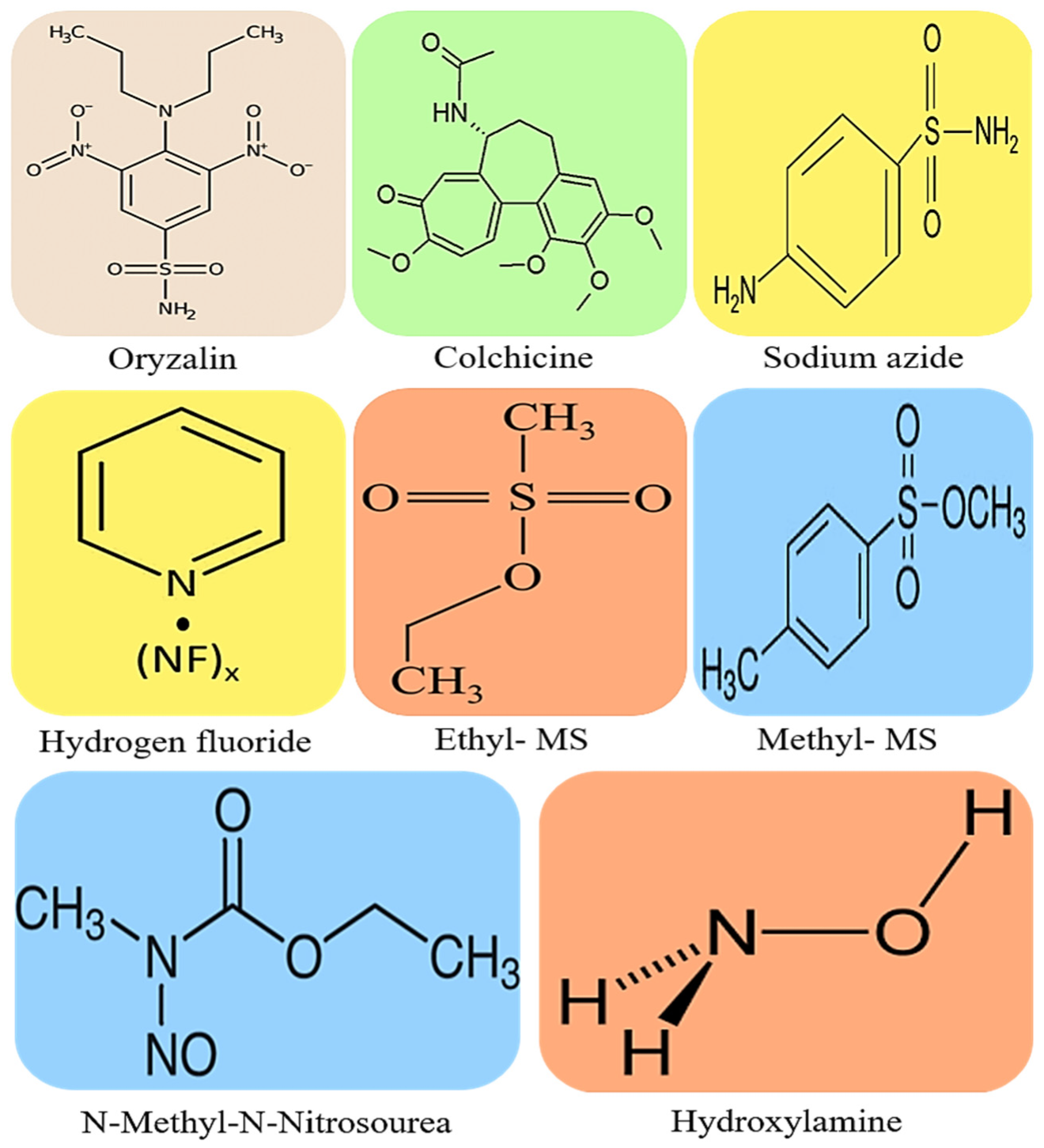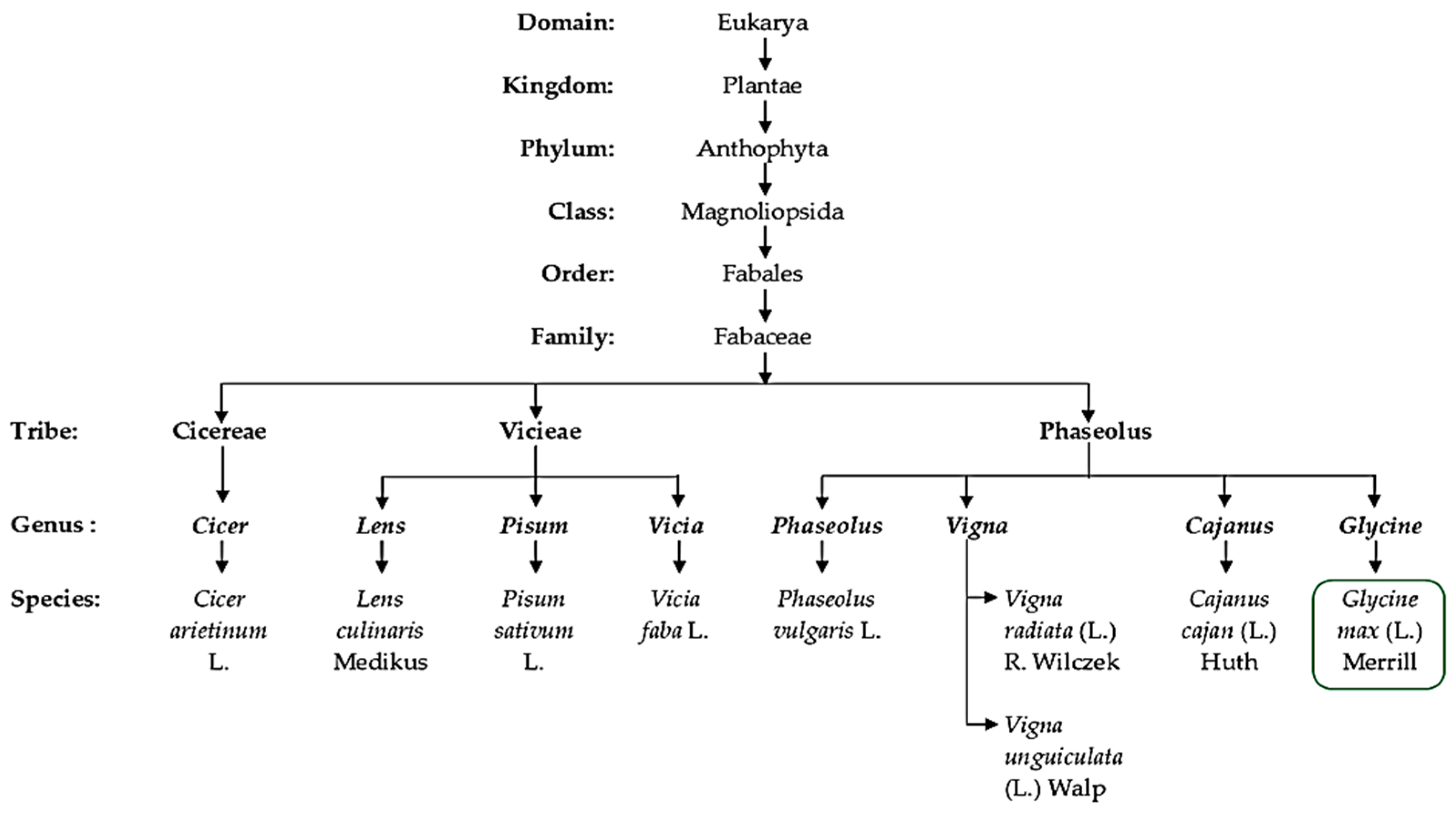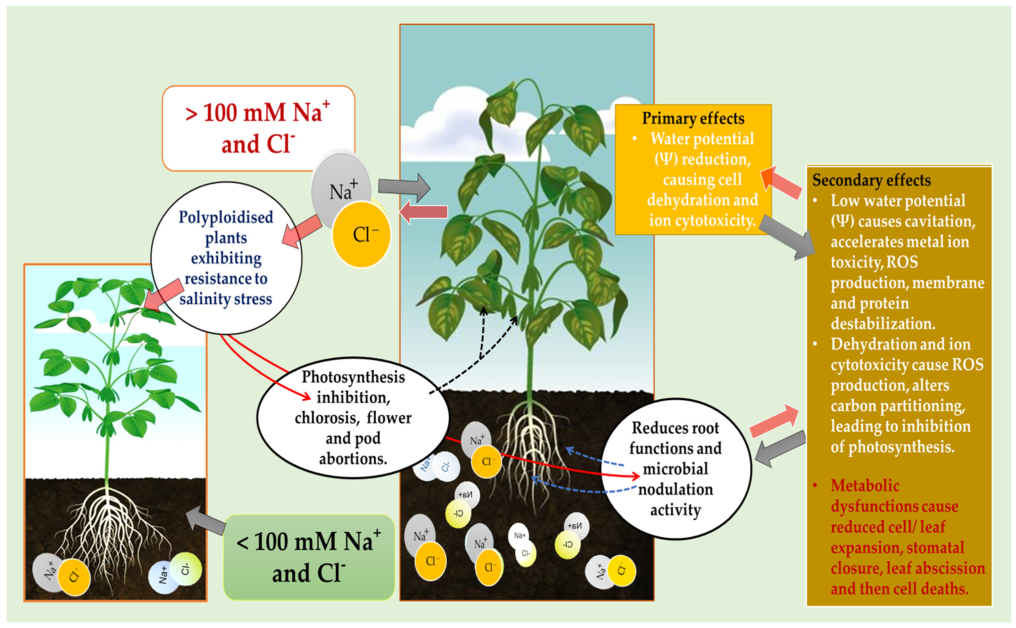Impact of Polyploidy Induction for Salinity Stress Mitigation in Soybean (Glycine max L. Merrill)
Abstract
1. Introduction
2. Genetic Architecture and Response to Salinity Stress in Soybean
3. Improvement of Salt Stress Tolerance via Polyploidy Induction in Plants
3.1. Vegetative Growth Characteristics for Salinity Tolerance
3.2. Enhanced Biochemical and Physiological Responses
4. Ploidy Stability and Molecular Profile for Salinity Stress Resistance in Soybean
5. Potential Undesirable Ploidy Effects
6. Future Prospects and Final Considerations
7. Conclusions
Funding
Data Availability Statement
Acknowledgments
Conflicts of Interest
References
- Kim, K.D.; El-Baidouri, M.; Abernathy, B.; Iwato-Otsubo, A.; Chavarro, C.; Gonzales, M.; Libaut, M.; Grimwood, J.; Jackson, S.A. A comparative epigeonomic analysis of polyploidy-derived genes in soybean and common bean. Plant. Physiol. 2015, 168, 1433–1447. [Google Scholar] [CrossRef] [PubMed]
- Manzoor, A.; Ahmad, T.; Bashir, A.; Hafiz, I.A.; Silvestri, C. Studies on colchicine induced chromosome doubling for enhancement of quality traits in ornamental plants. Plants 2019, 8, 194. [Google Scholar] [CrossRef] [PubMed]
- Juliao, S.A.; Ribeiro, C.V.; Lopes, J.M.L.; de Matos, E.M.; Reis, A.C.; Peixoto, P.H.P.; Machado, M.A.; Azevedo, A.L.S.; Grazul, R.M.; Campos, J.M.S.; et al. Induction of synthetic polyploids and assessment of genomic stability in Lippia alba. Front. Plant. Sci. 2020, 11, 292. [Google Scholar] [CrossRef] [PubMed]
- Sedivy, E.J.; Wu, F.; Hanzawa, Y. Soybean domestication: The origin, genetic architecture and molecular bases. New Physiol. 2017, 214, 539–553. [Google Scholar] [CrossRef]
- Oyegbami, A.; Fadairo, A.O.; Oyedokun, M.O. Women’s knowledge of the nutritional benefits and perceived constraints in soybean utilization in Oyo State, Nigeria. S. Afr. J. Agric. Ext. 2020, 48, 166–175. [Google Scholar] [CrossRef]
- Kang, Z.; Xiaowu, W.; Feng, C. Plant polyplidy: Origin, evolution and its influence on crop domestication. Horti. Plant J. 2019, 5, 231–239. [Google Scholar] [CrossRef]
- Al Nebaihi, H.; Le, T.S.; Davies, N.M.; Brocks, D.R. Liquid chromatography tandem mass spectrometric analytical method for study of colchicine in rats given low doses. Processes 2021, 9, 2007. [Google Scholar] [CrossRef]
- Katukojvala, S.; Barlett, K.N.; Lotesta, S.D.; Williams, L.J. Spirodiepoxides in total synthesis: Epoxomicin. J. Am. Chem. Soc. 2004, 126, 15348–15349. [Google Scholar] [CrossRef]
- Kantin, G.P.; Krasavin, M.Y. Microwave promoted reaction of N-(alk-1-enyl)chloroacetamides with sodium azide unexpectedly yields 1H-imidazol-5(4H)-ones. Mendocomm 2017, 27, 95–96. [Google Scholar] [CrossRef]
- Honma, M. An assessment of mutagenicity of chemical substances by (quantitative) structure-activity relationship. Gene Env. 2020, 42, 23. [Google Scholar] [CrossRef]
- Simontacchi, M.; Galatro, A.; Ramos-Artuso, F.; Santa-Maria, G.E. Plant survival in changing environment: The role of nitric oxide in plant response to abiotic stress. Front. Plant Sci. 2015, 6, 977. [Google Scholar] [CrossRef]
- Espina, M.J.; Ahmed, C.M.S.; Bernardini, A.; Adeleke, E.; Yadegari, Z.; Arielli, P.; Pantalone, V.; Taheri, A. Development and phenotypic screening of ethyl methane sulfonate mutant population in soybean. Front. Plant Sci. 2018, 9, 394. [Google Scholar] [CrossRef]
- Mastuti, R.; Munawarti, A.; Afiyanti, M. The effect of colchicine on in vitro growth of ciplukan (Physalis angulate). IOC Conf. Ser. Earth Environ. Sci. 2022, 1097, 012055. [Google Scholar] [CrossRef]
- Van der Hoorn, R.A.L.; Colby, T.; Nickel, S.; Richau, K.H.; Schmidt, J.; Kaiser, M. Mining the active proteome of Arabidopsis thaliana. Front. Plant Sci. 2021, 2, 89. [Google Scholar] [CrossRef]
- Schwarz, K.; Giul, R.; Schmidtke, G.; Kostka, S.; van der Broek, M.; Kim, K.B.; Crews, C.M.; Kraft, R.; Groettrup, M. The selective proteasome inhibitors lactacystatin and epoxomicin can be used to either up or down regulate antigen presentation at nontoxic does. J. Immunol. 2000, 164, 6147–6157. [Google Scholar] [CrossRef]
- Kisselev, A.F.; Goldberg, A.L. Proteosome inhibitor: From research tools to drug candidates. Chem. Biol. 2001, 8, 739–758. [Google Scholar] [CrossRef]
- Levie, J.; Belvalet, H.D.; Sonon, S.; Ion, A.M.; Dumon, E.; Melser, S.; Lacombe, D.; Dupuy, J.-W.; Lalou, C.; Benard, G. Ubiquitin-dependent degradation of mitochondrial protein regulates energy metabolism. Cell. Rep. 2018, 23, 2852–2862. [Google Scholar] [CrossRef]
- Meng, L.; Mohan, R.; Kwok, B.H.B.; Crews, C.M. Epoxomicin, a potent and selective proteasome inhibitor, exhibit in vivo anti-inflammatory activity. Proc. Natl. Acad. Sci. USA 1999, 96, 10403–10408. [Google Scholar] [CrossRef]
- Bouyer, D.; Geier, F.; Kragler, F.; Schnittger, A.; Pesch, M.; Wester, K.; Balkunde, R.; Timmer, J.; Fleck, C.; Hulskamp, M. Two-dimensional patterning by a trapping/depletion mechanism: The role of TTGI and GL3 in Arabidopsis trichome formation. PLoS Biol. 2008, 6, e141. [Google Scholar] [CrossRef]
- Silalahi, C.B.; Sinuraya, M.; Hanafiah, D.S.; Sipayung, R. The influence of oryzalin concentration on the plant growth of two tomato (Solanum lycopersicum L.) varieties. IOP Con Ser. Earth Env. Sci. 2019, 454, 012161. [Google Scholar] [CrossRef]
- Zhao, S.; Zhang, Q.; Liu, M.; Zhou, H.; Ma, C.; Wang, P. Regulation of plant response to salt stress. Int. J. Mol. Sci. 2021, 22, 4609. [Google Scholar] [CrossRef] [PubMed]
- Isayenkov, S.V.; Maathuis, F.J.M. Plant salinity stress: Many unanswered questions remain. Front. Plant Sci. 2019, 10, 80. [Google Scholar] [CrossRef] [PubMed]
- Zahra, N.; Raza, Z.A.; Mahmood, S. Effect of salinity stress on various growth and physiological attributes of two contrasting maize genotypes. Braz. Arch. Biol. Technol. 2020, 63, e20200072. [Google Scholar] [CrossRef]
- Morales, M.; Oakley, L.; Sartori, A.L.B.; Mogni, U.V.Y.; Atahuachi, M.; Vanni, R.O.; FRortunato, R.H.; Prado, D.E. Diversity and conservation of legumes in the Gran Chaco and biogeographical influences. PLoS ONE 2019, 14, e0220151. [Google Scholar] [CrossRef]
- Koenen, E.J.M.; Ojeda, D.I.; Bakker, F.T.; Weringa, J.J.; Kidner, C.; Hardy, O.J.; Pennington, R.T.; Herendeen, P.S.; Bruneau, A.; Hughes, C.E. The origin of the legumes is a complex paleopolyploid phylogenomic tangle closely associated with the Cretaceous-paleogene (K-Pg) mass extinction event. Syst. Biol. 2020, 70, 508–526. [Google Scholar] [CrossRef]
- Gill, N.; Findley, S.; Walling, J.G.; Hans, C.; Ma, J.; Doyle, J.; Stacey, G.; Jackson, S.A. Molecular and chromosomal evidence for allopolyploidy in soybean. Plant Physiol. 2009, 151, 1167–1174. [Google Scholar] [CrossRef]
- De la Estrella, M.; Forest, F.; Klitgard, B.; Lewis, G.P.; Mackinder, B.A.; de Queiroz, L.P.; Wieringa, J.J.; Bruneau, A. A new phylogeny-based tribal classification of subfamily Detarioideae, an early branching clade of florally diverse tropical arborescent legumes. Sci. Rep. 2018, 8, 6884. [Google Scholar] [CrossRef]
- Trytsman, M.; van Wyk, A.E.; Masemola, L. Systematics, diversity and forage value of indigenous legumes of South Africa, Lesotho and Swaziland. Afr. J. Biotechnol. 2011, 10, 13773–13779. [Google Scholar] [CrossRef]
- Idowu, G.A.; Fletcher, A.J. The manufacture and characterization of Rosid angiosperms-derived biochars applied to water treatment. BioEnergy Res. 2020, 13, 387–396. [Google Scholar] [CrossRef]
- Viviani, T.; Conte, L.; Cristofolini, G.; Speranza, M. Sero-systematic studies on the Phaseoleae (Leguminosae) and related tribes. Bot. J. Linn. Soc. 2008, 105, 113–136. [Google Scholar] [CrossRef]
- Zhu, J.-K. Abiotic stress signaling and responses in plants. Cell 2016, 167, 313–324. [Google Scholar] [CrossRef]
- Pi, E.; Qu, L.; Hu, J.; Huang, Y.; Qiu, L.; Lu, H.; Jiang, B.; Liu, C.; Peng, T.; Zhao, Y.; et al. Mechanism of soybean roots’ tolerance to salinity revealed by proteomic and phosphoproteomic comparison between two cultivars. Mol. Cell. Proteom. 2016, 15, 266–288. [Google Scholar] [CrossRef]
- Cai, X.; Jia, B.; Sun, X. Insights into the regulation of wild soybean tolerance to salt-alkaline stress. Front. Plant Sci. 2022, 13, 1002302. [Google Scholar] [CrossRef]
- Hasanuzzaman, M.; Bhuyan, M.H.M.B.; Anee, T.I.; Parvin, K.; Nahar, K.; Mahmud, J.A.; Fujita, M. Regulation of ascorbate-glutathione pathway in mitigating oxidative damage in plants under abiotic stress. Antioxidant 2019, 8, 384. [Google Scholar] [CrossRef]
- Lopez-Huertas, E.; Palma, J.M. Changes in glutathione, ascorbate, and antioxidant enzymes during olive fruit ripening. J. Agric. Food Chem. 2020, 68, 12221–12228. [Google Scholar] [CrossRef]
- Peng, Z.; He, S.; Sun, J.; Pan, Z.; Gong, W.; Lu, Y.; Du, X. Na+ compartmentalization related to salinity stress tolerance in upland cotton (Gossypium hirsutum) seedlings. Sci. Rep. 2016, 6, 34548. [Google Scholar] [CrossRef]
- Mishra, A.; Tanna, B. Halophytes: Potential resources for salt stress tolerance genes and promoters. Front. Plant Sci. 2017, 8, 829. [Google Scholar] [CrossRef]
- Alam, H.; Razaq, M.; Salahuddin. Induced polyploidy as a tool for increasing tea (Camellia sinensis L.) production. J. Northest Agric. Univ. 2015, 22, 43–47. [Google Scholar] [CrossRef]
- Forrester, N.J.; Ashman, T.-L. The direct effects of plant polyploidy on the legume-rhizobia mutualism. Ann. Bot. 2018, 121, 209–220. [Google Scholar] [CrossRef]
- Boukar, O.; Abberton, M.; Oyatomi, O.; Togola, A.; Tripathi, L.; Fatokum, C. Introgression breeding in cowpea [Vigna unguiculata (L.) Walp.]. Front. Plant Sci. 2020, 11, 567425. [Google Scholar] [CrossRef]
- Munzbergova, Z. Colchicine application significantly affect plant performance in the second generation of synthetic polyploids and its effects vary between populations. Ann. Bot. 2017, 120, 329–339. [Google Scholar] [CrossRef] [PubMed]
- Pavlikova, Z.; Pastova, L.; Munzbergova, Z. Synthetic polyploids in Vicia cracca: Methodology, effects on plant performance and aneuploidy. Plant Syst. Evol. 2017, 303, 827–839. [Google Scholar] [CrossRef]
- Mo, L.; Chen, J.; Lou, X.; Xu, Q.; Dong, R.; Tong, Z.; Huang, H.; Lin, E. Colchicine-induced polyploidization in Rhododendron fortunei Lindl. Plant 2020, 9, 424. [Google Scholar] [CrossRef] [PubMed]
- Noori, S.A.S.; Norouzi, M.; Karimzadeh, G.; Shirkool, K.; Niazian, M. Effect of colchicine-induced polyploidy on morphological characteristics and essential oil composition of ajowan (Trachyspermum ammi L.). Plant Cell. Tiss. Org. Cult. 2017, 130, 534–551. [Google Scholar] [CrossRef]
- Luo, Z.; Iaffaldano, B.J.; Cornish, K. Colchicine-induced polyploidy has the potential to improve rubber yield in Taraxacum kok-saghyz. Ind. Crops Prod. 2018, 112, 75–81. [Google Scholar] [CrossRef]
- Jeloudar, N.I.; Chamani, E.; Shokouhian, A.-A.; Zakaria, R.A. Induction and identification of polyploidy by colchicine treatment in Lilium regale. Cytologia 2019, 84, 271–276. [Google Scholar] [CrossRef]
- Kushwah, K.S.; Verma, R.C.; Patel, S.; Jain, N.K. Colchicine induced polyploidy in Chrysanthemum carinatum L. Phylogenetics Evol. Biol. 2018, 6, 1. [Google Scholar] [CrossRef]
- Palmar, R.G. Aneuploids in the soybean, Glycine max. Genome 2011, 16, 441–447. [Google Scholar] [CrossRef]
- Rauf, S.; Ortiz, R.; Malinowski, D.P.; Clarindo, W.R.; Kainat, W.; Schehzad, M.; Waheed, U.; Hassan, S.W. Induced polyploidy: A tool for forage species improvement. Agriculture 2021, 11, 210. [Google Scholar] [CrossRef]
- Debkeviciene, G.; Kemesyte, V.; Statkeviciute, G.; Lemeziene, N.; Brazauskas, G. Authopolyploids in fodder grass breeding: Induction and field performance. Span. J. Agric. Res. 2017, 15, e0706. [Google Scholar] [CrossRef]
- Innes, L.A.; Denton, M.D.; Dundas, I.S.; Pech, D.M.; Humphries, A.W. The effect of ploidy number on vigor, productivity, and potential adaptation to climate change in annual Medicago species. Crop. Sci. 2021, 61, 89–103. [Google Scholar] [CrossRef]
- Venial, L.R.; Mendonca, M.A.C.; Amaral-Silva, P.M.; Canal, G.B.; Passos, A.B.R.J.; Ferreira, A.; Soures, T.C.B.; Clarindo, W.R. Autotetraploid Coffea canephora and auto-alloctapleid Coffea arabica from in vitro chromosome set doubling: New germplasm for Coffea. Front. Plant Sci. 2020, 11, 154. [Google Scholar] [CrossRef]
- Lestari, P.; Roostika, I.; Nugroho, K.; Edison, H.S.; Rijzaani, H.; Mastar, M. Genetic stability of banana plant regenerated from floral axis organogenesis assessed by newly developed SSR markers. AGRIVTA J. Agric. Sci. 2019, 41, 302–315. [Google Scholar] [CrossRef]
- Wendel, J.F.; Lisch, D.; Hu, G.; Manson, A.S. The long and short of doubling down: Polyploidy, epigenetics and the temporal dynamics of genome fractionation. Curr. Opin. Gnetic Dev. 2018, 48, 1–7. [Google Scholar] [CrossRef]
- Kolar, F.; Certner, M.; Suda, J.; Schonswetter, P.; Husband, B.C. Mixed ploidy species: Progress and opportunities in polyploid research. Trends Plant Sci. 2017, 22, 1041–1055. [Google Scholar] [CrossRef]
- Xue, H.; Zhang, F.; Zhang, Z.-H.; Fu, J.-F.; Wang, F.; Zhang, B.; Ma, Y. Differences in salt tolerance between diploid and autotetraploid apple seedlings exposed to salt stress. Sci. Hort. 2015, 190, 24–30. [Google Scholar] [CrossRef]
- Ruiz, M.; Quimones, A.; Martinez-Cuenca, M.R.; Aleza, P.; Morillon, R.; Navarro, L.; Primo-Millo, E.; Martinez-Alcantara, B. Tetraploidy enhances the ability to exclude chloride from leaves in Carrizo citrange seedlings. J. Plant Physiol. 2016, 205, 1–10. [Google Scholar] [CrossRef]
- Oustric, J.; Quilichini, Y.; Morillon, R.; Herbette, S.; Luro, F.; Giannettini, J.; Berti, L.; Santini, J. Tetraploid Citrus seedlings subjected to long-term nutrient deficiency are less affected at the ultrastructural, physiological and biochemical levels than diploid ones. Plant Physiol. Biochem. 2019, 135, 375–384. [Google Scholar] [CrossRef]
- Rao, S.; Tian, Y.; Xia, X.; Li, Y.; Chen, J. Chromosome doubling mediates superior drought tolerance in Lycium ruthenicum via abscisic acid signaling. Hort. Res. 2020, 7, 40. [Google Scholar] [CrossRef]
- Chen, H.; Lu, Z.; Wang, J.; Chen, T.; Gao, J.; Zheng, J.; Zhang, J.; Zhang, S.; Xi, J.; Huang, X.; et al. Induction of new tetraploid genotypes and heat tolerance assessment in Asparagus officinalis L. Sci. Hort. 2020, 264, 109168. [Google Scholar] [CrossRef]
- Li, M.; Zhang, C.; Hou, L.; Yang, W.; Liu, S.; Pang, X.; Li, Y. Multiple responses contribute to the enhanced drought tolerance of the autotetraploid Ziziphus jujube Mill. Var. Spinosa. Cell. Biosci. 2021, 11, 119. [Google Scholar] [CrossRef] [PubMed]
- Jin, Y.; Zhao, Y.; Ai, S.; Chen, X.; Liu, X.; Wang, H.; Han, Y.; Ma, F.; Li, C. Induction of polyploid Malus prunifolia and analysis of its salt tolerance. Tree Physiol. 2022, 42, 2100–2115. [Google Scholar] [CrossRef] [PubMed]
- Otto, S.P. The evolutionary consequences of polyploidy. Cell 2007, 131, 452–462. [Google Scholar] [CrossRef] [PubMed]
- Weiss-Schneeweiss, H.; Emadzade, K.; Jang, T.S.; Schneeweiss, G.M. Evolutionary consequences, constraints and potential of polyplody in plants. Cytogenet. Genome Res. 2013, 140, 137–150. [Google Scholar] [CrossRef]
- Palmer, R.G.; Sandhu, D.; Curran, K.; Bhattacharyya, M.K. Molecular mapping of 36 soybean male-sterile, female-sterile mutants. Theor. Appl. Genet. 2008, 117, 711–719. [Google Scholar] [CrossRef]
- Fox, D.T.; Soltis, D.E.; Solitis, P.S.; Ashman, T.-L.; Van de Peer, Y. Polyploidy: A biological force from cells to ecosystems. Trend Cell. Biol. 2020, 30, 688–694. [Google Scholar] [CrossRef]
- Spoelhof, J.P.; Soltis, D.E.; Soltis, P.S. Habitat shape affects polyploid establishment in a spatial, stochastic model. Front. Plant Sci. 2020, 11, 592356. [Google Scholar] [CrossRef]
- Van de Peer, Y.; Ashman, T.-L.; Soltis, P.S.; Soltis, D.E. Polyploidy: An evolutionary and ecological force in stressful times. Plant Cell. 2021, 33, 11–26. [Google Scholar] [CrossRef]
- Scholes, D.R.; Paige, K.N. Plasticity in ploidy: A generalized response to stress. Trend Plant Sci. 2015, 20, 165–175. [Google Scholar] [CrossRef]
- Tossi, V.; Tosar, L.J.M.; Laino, L.E.; Lannicelli, J.; Regalado, J.J.; Escandon, A.S.; Baroli, I.; Causin, H.F.; Pitta-Alvarez, S.I. Impact of polyploidy on plant tolerance to abiotic and biotic stress. Front. Plant Sci. 2022, 13, 869423. [Google Scholar] [CrossRef]
- Khatoon, S.; Ali, S.I. Chromosome numbers and polyploidy in the legumes of Pakistan. Pak. J. Bot. 2006, 38, 935–945. [Google Scholar]
- Singh, R.J.; Chung, G.H. Cytogenetics of soybean: Progress and perspectives. Nucleus 2007, 50, 403–425. [Google Scholar]
- Cai, D.T.; Chen, J.G.; Chen, D.L.; Dai, B.C.; Zhang, W.; Song, Z.J.; Yan, Z.F.; Du, C.D.; Tang, Z.Q.; He, Y.C.; et al. The breeding of two polyploid rice lines with the characteristics of polyploid meiosis stability. Sci. China Ser. C Life Sci. 2007, 50, 356–366. [Google Scholar] [CrossRef]
- Ijaz, U.; Adhikari, K.N.; Stoddard, F.L.; Trethwan, R.M. Rust resistance in faba bean (Vicia faba L.): Status and strategies form improvement. Aust. Plant Pathol. 2018, 47, 71–81. [Google Scholar] [CrossRef]




| Tribe | Species Name | Common Name |
|---|---|---|
| Cicereae | Cicer arietinum | chickpea |
| Dalbergieae | Arachis hypogeae | Peanut |
| Genisteae | Lupinus luteus | Yellow lupin |
| Indigofereae | Cyamopsis tetragonoloba | Guar |
| Phaseoleae | Cajanus cajan | Pigeon pea |
| Canavalia ensiformis | Horse bean | |
| Glycine max | Soybean | |
| Mucuna pruriens | Velvet bean | |
| Phaseolus lanatus | Butter bean | |
| Phaseolus acutifolius | Tepary bean | |
| Phaseolus vulgaris | Dry bean | |
| Vigna radiata | Mung bean | |
| Vigna mungo | Black gram | |
| Vigna umbellate | Rice bean | |
| Vigna unguiculata | Cowpea | |
| Vicieae | Lens culinaris | Lentil |
| Pisum sativum | Pea | |
| Vicia faba | Broad bean |
Disclaimer/Publisher’s Note: The statements, opinions and data contained in all publications are solely those of the individual author(s) and contributor(s) and not of MDPI and/or the editor(s). MDPI and/or the editor(s) disclaim responsibility for any injury to people or property resulting from any ideas, methods, instructions or products referred to in the content. |
© 2023 by the author. Licensee MDPI, Basel, Switzerland. This article is an open access article distributed under the terms and conditions of the Creative Commons Attribution (CC BY) license (https://creativecommons.org/licenses/by/4.0/).
Share and Cite
Mangena, P. Impact of Polyploidy Induction for Salinity Stress Mitigation in Soybean (Glycine max L. Merrill). Plants 2023, 12, 1356. https://doi.org/10.3390/plants12061356
Mangena P. Impact of Polyploidy Induction for Salinity Stress Mitigation in Soybean (Glycine max L. Merrill). Plants. 2023; 12(6):1356. https://doi.org/10.3390/plants12061356
Chicago/Turabian StyleMangena, Phetole. 2023. "Impact of Polyploidy Induction for Salinity Stress Mitigation in Soybean (Glycine max L. Merrill)" Plants 12, no. 6: 1356. https://doi.org/10.3390/plants12061356
APA StyleMangena, P. (2023). Impact of Polyploidy Induction for Salinity Stress Mitigation in Soybean (Glycine max L. Merrill). Plants, 12(6), 1356. https://doi.org/10.3390/plants12061356







